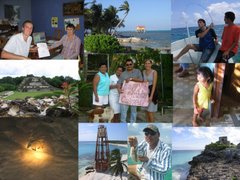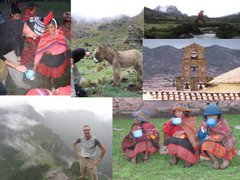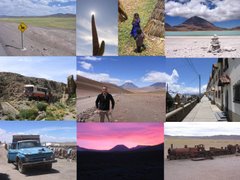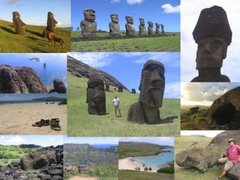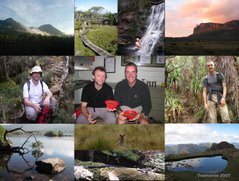What to say about the past week? There´s so much I could ramble on about: a 4 day trek through the Andes, altitude sickness at 16,000 feet, visiting extremely poor and remote villages in the mountains, Christmas Day (with mulled wine) in a tent, one of the greatest (and weirdest) train journeys in the world and an incredible day at Machu Picchu.
I don’t have much time to update the website before I have to leave for Bolivia, so once again, ill just let the pictures do the talking. Here´s a few photos from the first couple of days.
Cusco and AroundHadn´t done much travel planning beyond Belize - I thought Cusco was a small town, not a city of 500,000 people – doh. (Wearing my BCVI t-shirt in this pic!)
Cusco is truly built for taking photographs. The weather has been pretty mixed and it took me a while to adjust to the altitude of 3300m.
After a couple of days on my own in Cusco. I met up with the Dragoman group that I´ll be touring around Peru, Bolivia and Chile with for the next month. There are seven of us at the moment, though we´re losing a couple of people in the next few days.The first part of the tour was a four-day trek of the Lares Valley in the Andes. This was a little different to the typical Inca Trek as we were also visiting remote Andean farming communities with traditions dating back to the time of the Incas.Our first stop was in Quisharani, a village of a couple of hundred people at a height of 3,850 metres. We were dropped off by our bus with all our possessions for the next 3 days in the wilderness. After two days in Cusco I´d gotten over the tiredness, loss of apetite (no really!) and breathlessness at 3,300 metres, but this was higher still. A restless night under an incredibly clear, star-filled sky followed. But in the morning, the views were spectacular.

From Quisharani to Cuncan
The first night at altitude was bad. And we had barely started the trek the next morning when the effects of altitude on the body became clear. By the time we reached the peak for that day at 4,500 metres, one of our group of seven had spent most of the day on the emergency donkey and two of the others were struggling badly.
I had a pounding headache for a few hours, but the fantastic scenery was incentive enough to keep going. Only four of us survived to walk on the next day and I would have been more than disappointed not to be one of them.
Our second camp was at the village of Cuncan at 3,800m. As in the previous village we were welcomed by the locals, though neither we nor they seemed exactly clear on what our respective roles were. The intention of the alternative route is to give a more rewarding experience to the traveller by taking them away from the busy classic trail and giving them exposure to more remote and poorer local communities. Also, both through having the opportunity to sell souvenirs to travellers and through the fraction of the trip cost that goes towards the funding of education and other services, two of the poorest communities in the Andes can at least receive some benefit from the huge cash-cow that is tourism in the Peruvian Andes.A highly competitive game of football in Cuncan, the second village we visited.
In practise, I found that there wasnt a lot of interaction between ourselves and the commnities. We were warmly welcomed, and the locals were very friendly and keen to sell us local handicrafts. However, we didn’t really have any structured interaction with the locals beyond an impromptu football game and giving out hot chocolate and buns.
As it was Christmas, we gave out hot chocolate and buns to the locals. This was obviously a real treat for children and adults alike.
I would like to have seen more about how activities in the community worked , forexample the local school, which was being funded partly through the money we paid for the trip. Though the fact that the school had closed for Chistmas was a bit of an impediment.
Throughout our trip we were catered for by a group of five porters and two chefs. We also had our very experienced and knowledgable guide ‘Smithy’ - far left in this picture, next to Adrienne, Ali, Diana and Clint.From Cancun to the Sacred Valley
Activity in the communities ends shortly after nightfall, or in our case, a short while after dishing out the chocolate and buns. The next morning, our reduced group set out for the longest day – a nine hour hike up to 4,800m. The following photographs don’t quite capture how incredible the views were and how tough the climb was.
Christmas Day was also the final day of the trekand we had a beautiful four hour walk down into the Sacred Valley, from where we would catch the train to Machu Picchu the next morning.
Overall, though i thought the tour could be improved a bit, I was really impressed with the experience, and in particular with the work that Dragoman and Andina travel are doing in the villages. As I mentioned back in August, I intend to use some of the money I raised through sponsorship to help local causes that I see on my travels. I gave 200 US dollars to Andina travel as a donation to the villages of Quisharani and Cuncan. Thanks again for your donations and I will post details of how the money has been used. Ta.
Our camp on Christmas Eve was in an incredibly remote and beautiful location. What a place to wake up on Christmas morning.
Wednesday, December 27, 2006
Peru
Saturday, December 16, 2006
With a Tear in My Eye…
Being a ‘glass-half-full’ kinda guy, I’m loathe to make this anything other than a cheery farewell to Belize. But leaving was hard! As a guy who watches It’s a Wonderful Life at this time of year (every year) and always ends up sobbing (poor little Zuzu’s petals!!), I have to say it was… emotional.
On the other hand, I’d like to look at it this way: the reason it was so difficult to leave is because everything has worked out so well for me here. I’ve been very fortunate. In particular, the project has been really rewarding for me (and should hopefully be of great value to BCVI), discovering Belize has been a joy, and I’ve made some great friends.
The Project has gone really well

“Do I really have to read this thing? It’s painful just picking it up.” I hand over my 22,000-word report to BCVI Director, Mrs Joan Musa.
Between June and August of this year, I walked 500 miles around Scotland (and London), raising over £3,000 of funding towards a Challenges WorldWide organised project with the Belize Council for the Visually Impaired. Now that the project is completed, what d id all that fundraising achieve? Was it worth it?
id all that fundraising achieve? Was it worth it?
When I arrived on the 7th of September my goal was to “develop a financial plan incorporating forecasts and financial planning advice to ensure financial sustainability for BCVI.”
Over the following three months, I carried out research into the eye-care sector in Belize, interviewed BCVI staff, and developed a financial model based on BCVI’s accounting system. The key outputs were (1) a 65-page report setting out all my findings, providing financial forecasts for BCVI to 2010 and setting out 9 key recommendations to help ensure future financial sustainability and; (2) a spreadsheet-based model, which BCVI staff will be able to use in future to carry out their own financial modelling.
The feedback I’ve had so far has been very positive – in the short term, BCVI’s director plans to share the report with BCVI’s key funders in advance of discussions about BCVI’s future funding. In the longer term, I hope some of the recommendations I’ve made will be adopted and will help strengthen BCVI’s finances. This will help BCVI extend their lifeline services to an even greater share of Belize’s poor population.

LEFT: Dana, Vic, Joan Samuels, Lisa, Joan Musa and Kaiser Sose
RIGHT: Dana takes Christa’s place behind the camera. Hi to Naomi and Mark who weren’t in on my last day.
Hope this reassures everyone who made a donation that the money was well spent, especially those of you who were beginning to suspect that your donations had gone into a slush fund to finance deep-sea diving, rampant consumption of rum/belikin, and the bribing of border guards.


 Honduras…
Honduras…



And lastly (new) Friends and Family
It was a real stroke of luck to stay with Evan and Mari. They fed me, entertained me and looked after me, and put up with my dodgy Spanish for three months - above and beyond the call of duty. I am extremely grateful.
I’ve made some great friends here. Hope it all goes well for Karin back in Sweden, Kirsty - who’s done a great job cataloguing the history of the Red Cross here and has made a superb documentary about it – and Dorothy, who’ll be here for almost another two years with Peace Corps.

And I will especially miss my long-suffering (at least as long as I was driving) travelling companion Teri.

Maybe the 3 months have passed pretty quickly, but it honestly feels more like I’ve been here for a year. I’ve really enjoyed life in Belize – if I win the lottery I’m coming back to do this permanently. But for now I have to move on.
Next stop deepest, darkest Peru. I’ll be out of email contact whilst in the mountains so I just want to say have a fab Christmas and New Year. Please keep in touch and I’ll be back online soon.
 Merry Xmas from Teri and I to one and all.
Merry Xmas from Teri and I to one and all.
 Sun sets on Belize
Sun sets on Belize
On the other hand, I’d like to look at it this way: the reason it was so difficult to leave is because everything has worked out so well for me here. I’ve been very fortunate. In particular, the project has been really rewarding for me (and should hopefully be of great value to BCVI), discovering Belize has been a joy, and I’ve made some great friends.
The Project has gone really well

“Do I really have to read this thing? It’s painful just picking it up.” I hand over my 22,000-word report to BCVI Director, Mrs Joan Musa.
Between June and August of this year, I walked 500 miles around Scotland (and London), raising over £3,000 of funding towards a Challenges WorldWide organised project with the Belize Council for the Visually Impaired. Now that the project is completed, what d
 id all that fundraising achieve? Was it worth it?
id all that fundraising achieve? Was it worth it?When I arrived on the 7th of September my goal was to “develop a financial plan incorporating forecasts and financial planning advice to ensure financial sustainability for BCVI.”
Over the following three months, I carried out research into the eye-care sector in Belize, interviewed BCVI staff, and developed a financial model based on BCVI’s accounting system. The key outputs were (1) a 65-page report setting out all my findings, providing financial forecasts for BCVI to 2010 and setting out 9 key recommendations to help ensure future financial sustainability and; (2) a spreadsheet-based model, which BCVI staff will be able to use in future to carry out their own financial modelling.
The feedback I’ve had so far has been very positive – in the short term, BCVI’s director plans to share the report with BCVI’s key funders in advance of discussions about BCVI’s future funding. In the longer term, I hope some of the recommendations I’ve made will be adopted and will help strengthen BCVI’s finances. This will help BCVI extend their lifeline services to an even greater share of Belize’s poor population.


LEFT: Dana, Vic, Joan Samuels, Lisa, Joan Musa and Kaiser Sose
RIGHT: Dana takes Christa’s place behind the camera. Hi to Naomi and Mark who weren’t in on my last day.
Hope this reassures everyone who made a donation that the money was well spent, especially those of you who were beginning to suspect that your donations had gone into a slush fund to finance deep-sea diving, rampant consumption of rum/belikin, and the bribing of border guards.


What it’s all about. BCVI and CARE at work
Travelling in Belize has been superb
And I managed to get to Mexico, Guatemala and Honduras as well.
Mexico
Travelling in Belize has been superb
And I managed to get to Mexico, Guatemala and Honduras as well.
Mexico

 Honduras…
Honduras…


And lastly (new) Friends and Family
It was a real stroke of luck to stay with Evan and Mari. They fed me, entertained me and looked after me, and put up with my dodgy Spanish for three months - above and beyond the call of duty. I am extremely grateful.
I’ve made some great friends here. Hope it all goes well for Karin back in Sweden, Kirsty - who’s done a great job cataloguing the history of the Red Cross here and has made a superb documentary about it – and Dorothy, who’ll be here for almost another two years with Peace Corps.

And I will especially miss my long-suffering (at least as long as I was driving) travelling companion Teri.

Maybe the 3 months have passed pretty quickly, but it honestly feels more like I’ve been here for a year. I’ve really enjoyed life in Belize – if I win the lottery I’m coming back to do this permanently. But for now I have to move on.
Next stop deepest, darkest Peru. I’ll be out of email contact whilst in the mountains so I just want to say have a fab Christmas and New Year. Please keep in touch and I’ll be back online soon.
 Merry Xmas from Teri and I to one and all.
Merry Xmas from Teri and I to one and all.  Sun sets on Belize
Sun sets on Belize Son of a Gun Gonna Have Big fun, erm… in Cayo
 A brief break in the rain at Cahal Pech
A brief break in the rain at Cahal PechFor my last trip in Belize I went back to Belize’s adventure capital San Ignacio (aka Cayo). Planned to relax (and catch up on sleep) after the hectic last week when I’d been working all
 hours to finish the project and the report.
hours to finish the project and the report. 
These lizards in Cayo are recovering well from near extinction, now that hunting and eating them are outlawed. They can be well over 6 feet long, tail included.
The last week has been the wettest of the year in Belize. The rainy season is supposed to be over, but the flooding in San Ignacio suggests otherwise. This footbridge is

 a key link between local villages and San Ignacio itself. It is usually well clear of the water.
a key link between local villages and San Ignacio itself. It is usually well clear of the water.The main road into San Ignacio is a few feet under the flood waters here. Fortunately, one other bridge links San Ignacio with the rest of Belize.
 And even on Thursday morning that was high above the flood waters.
And even on Thursday morning that was high above the flood waters. 
Most of Cayo’s adventure trips were washed out by the weather. I was quite happy to just chill out instead. Still managed to squeeze in one more Mayan site – the oldest inhabited site in Belize, Cahal Pech.
 Cahal Pech
Cahal Pech
Monday, December 11, 2006
Honduras
 Beautiful water, jungle and mountains of Honduras
Beautiful water, jungle and mountains of Honduras What to say about the Honduras trip?! It was part-joy and part-trial! It’s only fair to mention the positives first as the negatives were pretty much bad luck and misfortune. It’s a beautiful country for starters. Teri and I caught the boat from Punta Gorda in the South of Belize and almost immediately you can see the mountains of Guatemala and Honduras looming up through the
 heat-haze. As the barrier-reef extends right down to the Honduranian coastline, the waters are bright, and flat like a mirror.
heat-haze. As the barrier-reef extends right down to the Honduranian coastline, the waters are bright, and flat like a mirror.Leaving PG
The boat took an hour to Guatemala from where we took a cab another hour to the border with Honduras. After much passport stamping and fee-paying we were on the bus - two gringos loose in the wilds of Spanish-speaking Central America.

"One man went to Omoa..."
Omoa (above) was the first place we stayed. The coastal village has a long history, which must have been transformed when the Spanish arrived, and built a huge fort here in the 15th Century.


Cannons… n ...balls.
From Omoa, we had a couple of long bus rides from Omoa in the North West through to La Ceiba the North East of Honduras. The countryside was all jungle and misty mountainsides. A little into the interior, we had to change buses in San Pedro Sula, the largest city in Honduras, which seems to have a bit of a reputation as a kind-of Bogota of Central America.
 From La Ceiba, we caught the ferry to Roatan. Roatan is quiet, beautiful and laid back but compared to the mainland it seemed touristy. Up to that point, we had seen 6 other gringos in two days in Honduras.
From La Ceiba, we caught the ferry to Roatan. Roatan is quiet, beautiful and laid back but compared to the mainland it seemed touristy. Up to that point, we had seen 6 other gringos in two days in Honduras.And the bad parts? There was obviously something in the air when my 5-hour bus ride from Belize City to Punta Gorda pulled up 20 minutes out of BC with a puncture. I had an ominous feeling after that, and when the bus pulled up again two hours later behind a long queue of traffic, in the dark, in the middle of the hills and jungle I knew there were trouble at mill.

This is the wreck of a fruit-truck that, on Thursday morning, had been heading from Southern Belize to the capital when at about 2.30 in the afternoon it skidded, jacknived and blocked the entire road. When we arrived at 6.30, this was pretty much the scene: a score of blokes throwing grapefruit everywhere. There was nowhere for traffic to pass, but luckily bus drivers on opposite sides of the crash had the great idea of swapping passengers and then turning back (there is only one road from the capital to the very south of the country) to where they started, so I still got to PG that night, about 8 hours after setting out…

It’s always best to make the most out of adversity. I nabbed a grapefruit and smuggled it through Guatemala and into Honduras where Teri and I had it for breakfast on Friday morning.
 Fledgling airline Air Honduras suddenly realises the impracticality of spending its entire aircraft budget on glamorous air-hostesses…
Fledgling airline Air Honduras suddenly realises the impracticality of spending its entire aircraft budget on glamorous air-hostesses…All in all, it took about 8 hours by coach, then an hour by boat, an hour in a cab, two plus one plus four hours in another 3 buses and then an hour by catamaran to get to Roatan. Faced with this return trip and dicky tummies, we opted for the luxury of flying back to Belize. In comparison with buses and boats, even three flights in a tiny plane with a two hour delay in the middle was little to gripe about, though we were a bit miffed when we were moved from the back of the plane to the front, to help ‘balance things up’. Best not to argue with pilots or aircraft mechanics though, I find.
All that was nothing though, compared to the big trauma of the weekend – food poisoning! I don't know whether it was the food or the water, but i was on my back (or more often in the loo) for the whole of Saturday and didn't eat anything for 36 hours (very, very unlike me). Teri was then sick too, just as i was getting better. Our big plans for jungle walks and exploring had to be ditched, but at least where we were staying had a beautiful beach to flake out on.
 "Teri, I think there's only one solution for my problem...", "Don't worry Calum, I've found it already..." The Honduranian over-the-counter remedy for the runs.
"Teri, I think there's only one solution for my problem...", "Don't worry Calum, I've found it already..." The Honduranian over-the-counter remedy for the runs.In that last day I somehow also managed to lose my bankcard (machine at the airport ate it) and my sunglasses (don’t even know where I lost those). I just can’t cope with a 4am start… It was almost a relief to get back to the relative safety of Belize City, where there had been just four shootings since I'd left the previous Thursday.

Subscribe to:
Posts (Atom)










